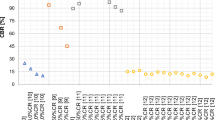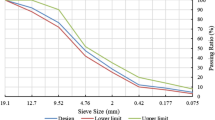Abstract
Crumb rubber derived from end-of-life tires is nowadays considered as a valuable component to be employed for the production of high-performance bituminous binders and mixtures. Currently available technologies require such a material to be either pre-mixed with bitumen (“wet” method), with the consequent production of the so-called asphalt rubber binders, or to be added during the mixing of aggregates and bitumen (“dry” method), thereby leading to the preparation of rubberized dry mixtures. Depending upon the case, different interactions take place between bitumen and crumb rubber, resulting in mechanical properties of the final mixture which can increase its performance in the field under the effects of loading and environmental factors. The laboratory investigation presented in this paper focused on the issue of bitumen–crumb rubber affinity with the main purpose of developing a simple laboratory procedure which can be employed to support the formulation of rubberized dry mixtures. Affinity between bitumen and coarse crumb rubber, with particle sizes comprised between 1 and 4 mm, was evaluated by subjecting mortars of known composition to the volumetric expansion test (VET). Measured volumetric behavior was compared to that of reference blends prepared with the same base bitumen and inert silica sand. Obtained results were interpreted by taking into account phenomena which may occur during testing at bitumen-particle interfaces, allowing a quantitative comparison between crumb rubbers of different types. Moreover, an affinity parameter was defined, with the consequent possibility of assessing bitumen–crumb rubber affinity in absolute terms.









Similar content being viewed by others
References
Abdelrahman MA (2006) Controlling performance of crumb rubber-modified binders through addition of polymer modifiers. Transp Res Rec 1962:64–70
Abdelrahman MA, Carpenter SH (1999) Mechanism of interaction of asphalt cement with crumb rubber modifier. Transp Res Rec 1661:106–113
Amirkhanian SN (2001) Utilization of crumb rubber in asphaltic concrete mixtures—South Carolina’s experience. research report, Clemson University, Clemson, SC, USA
ASTM D6114 (2009) Standard specification for asphalt-rubber binder. ASTM International, West Conshohocken
Attia M, Abdelrahman M (2009) Enhancing the performance of crumb rubber-modified binders through varying the interaction conditions. Int J Pavement Eng 10(6):423–434
Bahia HU, Davis R (1994) Effect of crumb rubber modifiers (CRM) on performance-related properties of asphalt binders. J Assoc Asphalt Paving Technol 63:414–449
Caltrans (State of California Department of Transportation) (2005) Synthesis of Caltrans rubberized asphalt concrete projects. Caltrans, Sacramento
Caltrans (State of California Department of Transportation) (2005) Use of scrap tire rubber. State of the technology and best practices. Caltrans, Sacramento
EN 1097-7 (2008) Tests for mechanical and physical properties of aggregates. Determination of the particle density of filler. Pycnometer method. European Committee for Standardization (CEN), Brussels
EN 12697-5 (2003) Bituminous mixtures. Test methods for hot mix asphalt. Determination of the maximum density. European Committee for Standardization (CEN), Brussels
Epps JA (1994) Uses of recycled rubber tyres in highways. NCHRP report—synthesis of highway practice 198. TRB National Research Council, Washington, D.C., USA
Frantzis P (2004) Crumb rubber–bitumen interactions: diffusion of bitumen into rubber. J Mater Civ Eng 16(4):387–390
Green E, Tolonen W (1977) The chemical and physical properties of asphalt rubber mixtures, part I—basic material behaviour. Report FHWA-AZ-HPR14-162, Arizona Department of Transportation, Phoenix, Arizona, USA
Heitzman MA (1992) State of the practice—design and construction of asphalt paving materials with crumb rubber modifier. Report FHWA-SA-92-022, Washington, D.C., USA
Hicks RG (2002) Asphalt rubber design and construction guidelines. Northern California rubberized asphalt concrete technology center—California Integrated Waste Management Board, Sacramento, CA, USA
Khalid HA, Artamendi I (2002) Exploratory study to evaluate the properties of rubberised asphalt modified using the wet and dry processes. In: Proceedings of the 3rd international conference, bituminous mixtures and pavements, Thessaloniki, Greece
Lee S, Akisetty CK, Amirkhanian S (2008) The effect of crumb rubber modifier (CRM) on the performance properties of rubberized binders in HMA pavements. Constr Build Mater 22:1368–1376
Newcomb DE, Stroup-Gardiner M, Kim JR, Allen B, Wattenhoffer-Spry J (1994) Polymerized crumb rubber modified mixtures in Minnesota. Mn/DOT report 69075, University of Minnesota, Minneapolis, Minnesota, USA
Oliver J (1981) Modification of paving asphalts by digestion with scrap rubber. Transp Res Rec 821:37–44
Province of Turin (2011) TYREC4LIFE: development and implementation of innovative and sustainable technologies for the use of scrap tyre rubber in road pavements. LIFE+research proposal
Putman BJ, Amirkhanian S (2006) Crumb rubber modification of binders: interaction and particle effects. In: Proceedings of the asphalt rubber 2006 conference, Palm Springs, CA, USA
Santagata E, Bassani M (2002) Evaluation of bitumen–aggregate interactions by means of volumetric expansion tests. In: Proceedings of the 4th BITMAT, European symposium on performance of bituminous and hydraulic materials in pavement, Nottingham, UK, pp 269–278
Santagata E, Zanetti MC (2012) The use of products from end-of-life tyres in road pavements. Ecopneus, Milan
Santagata E, Dalmazzo D, Lanotte M, Zanetti MC, Ruffino B (2012) Relationship between crumb rubber morphology and asphalt rubber viscosity. In: Proceedings of the 5th asphalt rubber international conference, Munich, Germany, pp 513–532
Santagata E, Lanotte M, Dalmazzo D, Zanetti MC (2013) Potential performance-related properties of rubberized bituminous mixtures produced with dry technology. In: Proceedings of the 12th international conference on sustainable construction materials, pavement engineering and infrastructure, Liverpool, UK
Santagata E, Zanetti MC, Corbetta G, Fornai D (2013) POLIPNEUS project. Science and technology of bituminous binders and mixtures containing crumb rubber from end-of-life tyres. Strade Autostrade 97:62–68
Shen J, Amirkhanian S (2005) The influence of crumb rubber modifier (CRM) microstructures on the high temperature properties of CRM binders. Int J Pavement Eng 6(4):265–271
Shen J, Amirkhanian S, Xiao F, Tang B (2009) Surface area of crumb rubber modifier and its influence on high-temperature viscosity of CRM binders. Int J Pavement Eng 10(5):375–381
Shen J, Amirkhanian S, Xiao F, Tang B (2009) Influence of surface area and size of crumb rubber on high temperature properties of crumb rubber modified binders. Constr Build Mater 23:1304–1310
Thodesen C, Shatanawi K, Amirkhanian S (2009) Effect of crumb rubber characteristics on crumb rubber modified (CRM) binder viscosity. Constr Build Mater 23:295–303
Way GB, Kaloush KE, Biligiri KP (2012) Asphalt-rubber standard practice guide, 2nd edn. Rubber Pavements Association, Tempe
West RC, Page GC, Veilleux J (1998) Effect of tyre rubber grinding method on asphalt–rubber binder characteristics. In: Proceedings of the TRB annual meeting, Washington, D.C., USA
Zanetti MC, Fiore S, Ruffino B, Santagata E, Dalmazzo D, Lanotte M (2014) Characterization of crumb rubber from end-of-life tyres for paving applications. In: Proceedings of SUM 2014, 2nd symposium on Urban Mining, Bergamo, Italy
Acknowledgments
The investigation described in this paper was carried out as part of the POLIPNEUS and TYREC4LIFE research projects, respectively funded by Ecopneus S.c.p.A. and by the European Commission.
Author information
Authors and Affiliations
Corresponding author
Rights and permissions
About this article
Cite this article
Santagata, E., Lanotte, M., Baglieri, O. et al. Analysis of bitumen–crumb rubber affinity for the formulation of rubberized dry mixtures. Mater Struct 49, 1947–1954 (2016). https://doi.org/10.1617/s11527-015-0625-3
Received:
Accepted:
Published:
Issue Date:
DOI: https://doi.org/10.1617/s11527-015-0625-3




